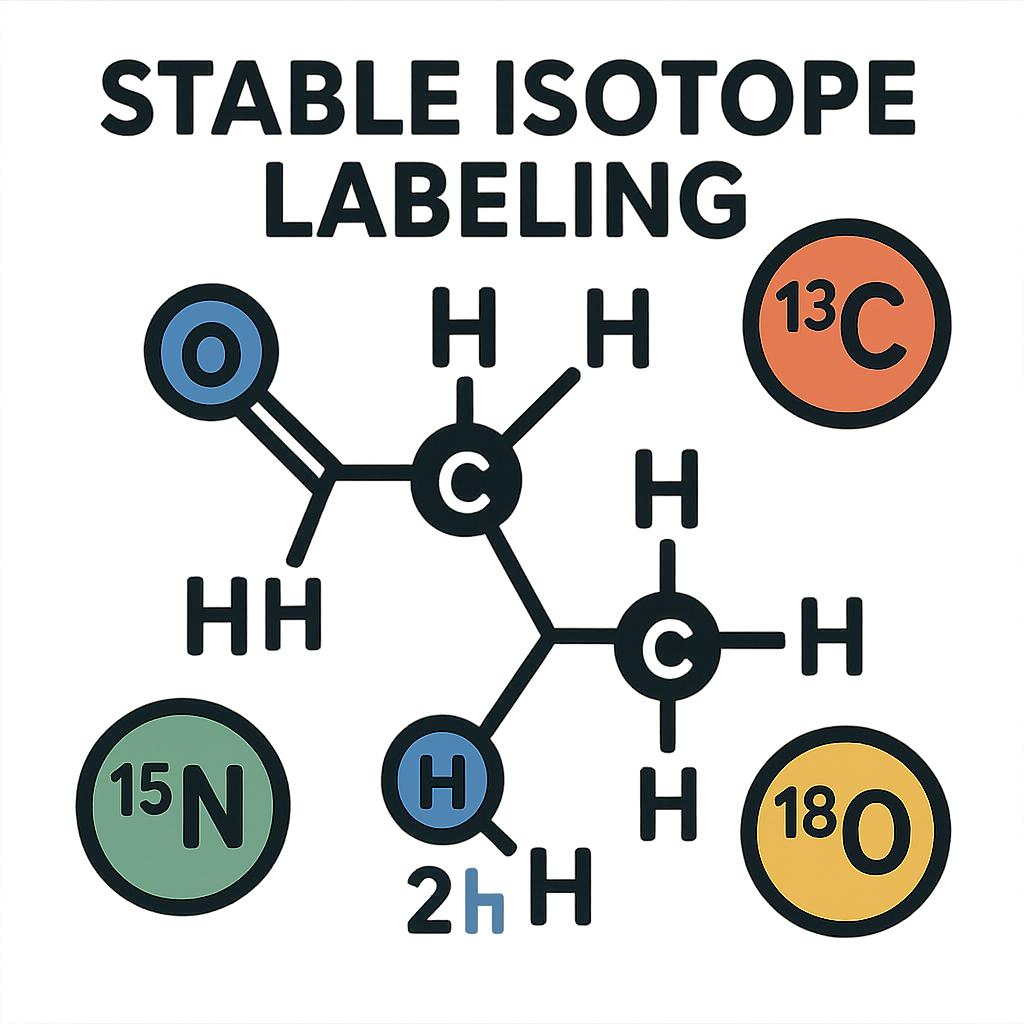Stable Isotope Labeling
Quantitative Accuracy Multiplexing Capability Dynamic Analysis Metabolic Tracking
Our Stable Isotope Labeling service offers precise and reliable quantitative analysis for proteomics and metabolomics research. By using non-radioactive isotopic labels, we enable accurate metabolic tracking and dynamic profiling of biological systems with high sensitivity. Ideal for researchers seeking multiplexing capabilities and isotopic precision, our service ensures robust data quality for advanced biomolecular studies.

What are Isotopes and Stable Isotope Labeling?
Isotopes are atoms of the same element that have the same number of protons but different numbers of neutrons. While many isotopes are radioactive and decay over time, stable isotopes do not undergo radioactive decay and are therefore safe to use in experimental settings. Some common stable isotopes used in research include 13C, 15N, 18O, 2H, and 34S. By substituting a few atoms of a compound with stable isotopes, researchers can create labeled molecules that behave identically to their natural counterparts. These isotopically labeled compounds can then be fed to cells or organisms, allowing for the tracking of their metabolic fate using analytical techniques such as mass spectrometry. Stable Isotope Labeling is a cutting-edge technique used in proteomics and metabolomics to accurately track and quantify biomolecules by incorporating non-radioactive, stable isotopes into samples. This method enhances sensitivity and precision in metabolic and protein analysis, enabling researchers to study dynamic biological processes with minimal interference. Widely applied in life sciences, Stable Isotope Labeling supports advanced quantitative research and biomolecular discovery.
Our Stable Isotope Labeling Services
Enhance your research with precise, high-quality stable isotope labeling solutions. Our comprehensive Stable Isotope Labeling (SIL) services support a wide range of applications, including proteomics, metabolomics, flux analysis, and drug development.
13C, 15N, 2H (D), 18O labeling
Tailor-made small molecules, amino acids, peptides, nucleotides
High chemical and isotopic purity (≥ 98%)
Scalability from milligram to gram quantities
Fast turnaround and stringent QC documentation
SILAC media preparation with isotopically labeled amino acids (13C6-Arg, 13C6-Lys, etc.)
Complete experimental setup, including:
Label incorporation monitoring
Cell viability and growth optimization
Proteomic sample preparation (trypsin digestion, desalting)
Data acquisition-ready samples for LC-MS/MS
13C- or 15N-based tracer studies
Time-course metabolic flux analysis (MFA)
Labeling in bacteria, yeast, mammalian cells, and plant systems
Support for downstream GC-MS, LC-MS, and NMR analysis
Quantitative pathway modeling and interpretation available
Uniform or site-specific 13C, 15N, and 2H labeling of proteins and peptides
Recombinant protein expression in labeled media
Sample preparation for solution-state or solid-state NMR
LC-MS/MS analysis of labeled samples
Isotopomer distribution analysis
Quality control and purity assessment of labeled compounds
Interpretation and visualization of isotopic labeling patterns
We perform metabolic stability analysis using stable isotope labeling, a crucial method for assessing compound metabolic stability and initiating enzyme effect studies.
By combining mass spectrometry with stable isotope labeling, we effectively identify metabolites of compounds, thus aiding drug development and toxicology studies.
We offer stable isotope labeling services to assist researchers in tracking and locating specific molecules or compounds within biological systems.
We provide standards and associated quantitative analysis services for stable isotope-labeled molecules to support precision medicine and personalized treatment.
Our team of experts can provide consultation services regarding stable isotope labeling techniques, including their applications in drug development, disease research, and more.
We offer a comprehensive range of stable isotope labeling solutions designed to support quantitative analysis, metabolic tracking, and structural elucidation across a variety of biomolecules. All services are performed with high purity materials and optimized protocols to ensure accurate, reproducible results.
Accurate peptide quantification and tracking using non-radioactive stable isotopes for proteomic studies.
Enhanced metabolic profiling of natural compounds through precise stable isotope incorporation.
High-sensitivity labeling for amino acids and derivatives to support detailed biochemical and metabolic analyses.
Targeted isotopic labeling of carbohydrates enabling precise metabolic flux and structural studies.
Enhance lipid metabolism studies and membrane dynamics with precise ¹³C, ²H, and ¹⁵N stable isotope labeling.
Track DNA and RNA synthesis and modifications using ¹³C, ¹⁵N, ²H, and ¹⁸O labeled nucleotides for advanced molecular biology research.
Perform metabolic flux analysis by incorporating ¹³C, ²H, and ¹⁵N isotopes into key small molecule metabolites.
Optimize pharmacokinetics and drug metabolism studies with deuterium (²H) and ¹³C labeled pharmaceutical compounds.
Investigate vitamin metabolism and distribution using stable isotope-labeled vitamins like B-complex derivatives.
Track biodegradation and interaction of biomaterials using stable isotopes incorporated into polymer chains.
Methodologies of Stable Isotope Labeling
In isotopic dilution, a small amount of a labeled compound is added to a larger, unlabeled sample. By measuring the change in isotopic composition, researchers can determine the concentration or turnover rate of the target compound in the sample.
Multiple isotope labeling involves using different isotopes of the same element to trace multiple pathways simultaneously. This technique is useful for studying complex metabolic networks or chemical reactions.
Positional labeling involves introducing isotopes at specific locations within a molecule to study the fate of those atoms during reactions or metabolic processes. This method is valuable for understanding reaction mechanisms and substrate preferences.
 Fig. 1 Methodology for absolute quantification using stable isotope labeling. (Chokkathukalam A, 2014)
Fig. 1 Methodology for absolute quantification using stable isotope labeling. (Chokkathukalam A, 2014)
General Workflow for Stable Isotope Labeling

The first step is to select the stable isotope that will be used for labeling. Common isotopes used include 13C, 15N, and 18O.
The biological system of interest, such as cells, tissues, or organisms, is then labeled with the stable isotope. This can be done through various methods such as growing cells in media containing labeled substrates or feeding labeled nutrients to organisms.
Samples are collected at specific time points or under specific conditions to capture the metabolic or biochemical processes of interest. Care should be taken to ensure accurate and representative sampling.
The labeled molecules are then extracted from the samples using appropriate methods like chromatography or mass spectrometry. The isotopic composition of the molecules is analyzed to determine the abundance of the labeled isotopes.
The data obtained from the analysis is then processed and interpreted to gain insights into metabolic pathways, protein dynamics, or flux rates within the biological system. This may involve comparing the abundance of labeled isotopes in different samples or conducting metabolic modeling.
The results of the stable isotope labeling experiment are visualized using graphs, tables, or other visualization techniques to communicate the findings. The results are then reported in scientific publications or presentations.
Competitive Advantages of Working with Us
We utilize top-tier, cutting-edge stable isotope labeling technology that enhances the precision and accuracy of results. Our methodology provides quick and dependable detections, empowering more efficient research and development processes.
Our team comprises of highly skilled and knowledgeable professionals who have substantial experience in stable isotope labeling. They are committed to delivering high-quality solutions that meet or exceed our clients' expectations.
We understand that each project has unique needs, and thus we offer personalized stable isotope labeling services tailored to align with our clients' specific objectives and requirements.
We adhere to stringent quality control procedures during each phase of stable isotope labeling to ensure the utmost reliability and validity.

From sample preparation to final analysis, we maintain a seamless workflow that guarantees speed, precision and cost-efficiency.
We prioritize the privacy and security of our clients' data at all times, adhering to strict confidentiality and data protection measures.
Due to our proficient operational procedures and the expertise of our team, we provide these services in a time-efficient manner thereby reducing downtime and accelerating project timelines.
Data analysis, detailed reports, results and discussions.
Fast shipping with full documentation (CoA, MS spectra, etc.)
Where Our Stable Isotope Labeling Are Used?
Stable isotope labeling enables metabolic flux analysis, which helps in studying the flow of nutrients and metabolites within biological systems. By tracking the fate of isotopically labeled molecules in metabolic pathways, researchers can elucidate the dynamics of cellular metabolism and identify potential drug targets for metabolic disorders.
Stable isotope labeling is essential for studying protein dynamics, turnover, and interactions. By incorporating isotopically labeled amino acids into proteins, researchers can track the synthesis and degradation rates of specific proteins, unraveling their roles in cellular processes and disease mechanisms.
Stable isotope labeling is crucial for drug development and metabolism studies. By using isotopically labeled compounds, researchers can investigate drug absorption, distribution, metabolism, and excretion in vivo, facilitating the design of safer and more effective therapeutic agents.
Stable isotope labeling is valuable for tracking pollutants and contaminants in the environment. By introducing isotopically labeled tracers into ecosystems, researchers can monitor the movement and transformation of pollutants, assess environmental risks, and develop strategies for remediation.
Stable isotope labeling is employed in food safety and authentication to trace the origin and authenticity of food products. By analyzing the isotopic signatures of food components, researchers can detect adulteration, fraud, and contamination in the food supply chain, ensuring consumer safety and regulatory compliance.
Case Study
Case Study 1
In a typical stable isotope labeling by amino acids in cell culture (SILAC) experiment, cells are labeled by growing in either medium with natural amino acids (light medium) or in medium containing one or more stable isotope labeled amino acids (heavy medium). In general, cells need to be maintained in SILAC media for at least five divisions to ensure virtually complete labeling of proteins. Then if needed, differential experimental treatments are performed. Equal amounts of the two differentially labeled cell populations or protein extracts are combined prior to further sample handling and processing steps as required by the experiment. Because trypsin is the most commonly used protease in proteomics and it cleaves carboxy-terminal to lysine and arginine residues, double labeling with lysine and arginine ensures that every tryptic peptide (except C-terminal peptides) contains a heavy amino acid and can be used for protein quantitation.
The advantage of this technique lies in its ability to introduce stable isotope-labeled amino acids into proteins through the normal growth metabolism of cells. This significantly simplifies the complexity of manual processing required for MS quantitative analysis. Currently, SILAC technology allows for labeling with stable isotopes such as 2H, 13C, and 15N in cell culture systems.
 Fig. 2 Protein quantifi cation using SILAC. (Esthelle Hoedt, 2019)
Fig. 2 Protein quantifi cation using SILAC. (Esthelle Hoedt, 2019)
Case Study 2
Isotope-coded affinity tag reagents (ICATs) can be used in mass spectrometry to help identify and quantify proteins. They work by reacting with the sulfhydryl groups of cysteine in denatured peptides and are designed to be used for analyzing biological systems. The ICATs consist of biotinylated iodoacetamide derivatives that react with the sulfhydryl groups attached to cysteine, using an intermediate bridge containing isotopic carbon or hydrogen atoms to establish differential labelling. These reagents allow for the isolation of specific peptides from a complex sample mixture, reducing the number of different molecules introduced into a mass spectrometer, simplifying the analysis. The ICAT labels come in two variants, a light version, and a heavier form where usual hydrogen or carbon atoms are replaced with more massive isotopes like 2H/13C. In the provided example, these light and heavy ICAT tags are used to label proteins from two different cell states, healthy and sick. The samples are then combined and broken down into peptides, allowing the labelled peptides to be isolated and analyzed by a mass spectrometer. The proportional intensity signals of the heavy/light tagged peptide pairs allow for determining the relative abundance between healthy and sick states of the peptide.
 Fig.3 ICAT reagents workflow. (Chahrour, 2015)
Fig.3 ICAT reagents workflow. (Chahrour, 2015)
Frequently Asked Questions (FAQ)
Stable Isotope Labeling is a method used to track the passage of an isotope, known as a label, through a biological system or pathway. This allows for accurate quantification of metabolites, peptides, and proteins.
Stable Isotope Labeling works by using isotopes that have the same chemical properties as their non-isotopic counterparts but can be distinguished by their mass difference. These isotopes are integrated into targeted molecules, which can then be tracked or quantified using mass spectroscopy-based techniques.
Stable Isotope Labeling is utilized in applications such as proteomics, metabolomics, and fluxomics research. It enables precise quantification and dynamic tracking of targeted molecules, aiding in the study of diseases, drug discovery, and biological processes.
Our Stable Isotope Labeling services use non-radioactive isotopes, hence they do not pose any radiation risks and are safe for research purposes.
The processing time for Stable Isotope Labeling can vary based on the complexity and scale of the experiment. Our team will provide you with an estimated timeline once we understand your specific needs.
The cost of Stable Isotope Labeling varies depending on the specifics of your project. Please reach out to our customer service team to discuss your needs and obtain a quote.
Stable Isotope Labeling is considered to be highly accurate due to its ability to track and quantify specific molecules. Isotopes are distinguished based on their unique mass, which reduces potential errors that can be incurred from overlapping signals.
Both natural and synthetic isotopes can be utilized in Stable Isotope Labeling. The choice of isotope depends on the nature of your experiment and the specific molecules you wish to track.interpretation of results.
Learn More About Stable Isotope Labeling
References
- Esthelle Hoedt, et al., Stable isotope labeling by amino acids in cell culture (SILAC) for quantitative proteomics, Advancements of Mass Spectrometry in Biomedical Research, 2019: 531-539.
- Chahrour, et al., Stable isotope labelling methods in mass spectrometry-based quantitative proteomics, Journal of Pharmaceutical and Biomedical Analysis, 2015, 113: 2-20.